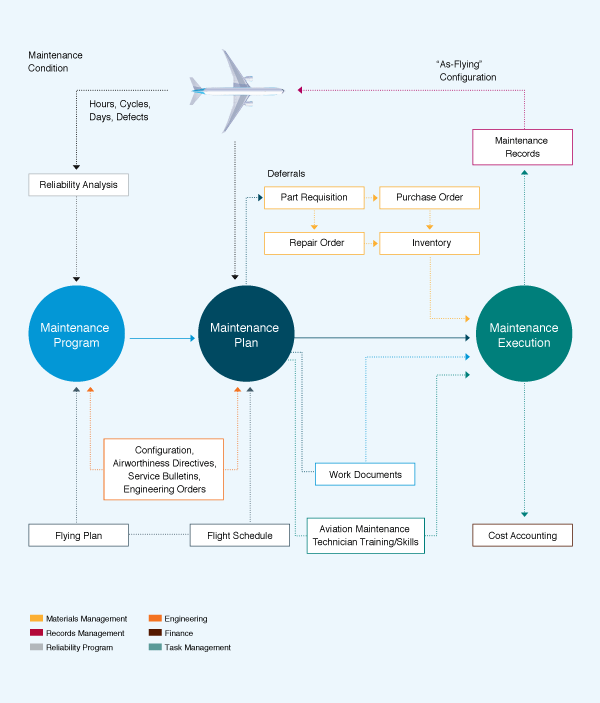
E-ENABLED TOOLS AND SERVICES
Boeing developed a number of e-Enabled solutions that help airlines improve their performance and enhance operational efficiencies. Many of these solutions are designed to help airlines achieve real-time visibility into all of their operations, including airplanes in flight (see fig. 1).
Figure 1: Elements of real-time visibility into airline operations
Operational efficiency requires system integration throughout an airline’s operations. The e-Enabled system environment integrates this real-time data with the airline’s maintenance planning systems. The operation of Boeing airplanes creates real-time performance data that is directed to an airline’s maintenance planning system and reliability system. This integration event enables just-in-time adjustments to planning, record management, and airline cost accounting with the objective of maintaining an “as-flying” airplane configuration.
Maintenance Performance Toolbox. This electronic performance support system provides operators with up-to-date fleet maintenance information using intelligent documents and visual navigation methods. It allows airline operators to streamline the management and distribution of technical information, including just-in-time training at the point of use. Toolbox is designed for use by technical operations staff responsible for airplane system troubleshooting, structural repair record management, parts management, task card management, content authoring, and training. Toolbox is an online subscription service delivered via the Web portal MyBoeingFleet.com and is built on an industry-standard Java 2 Platform, Enterprise Edition, architecture to ensure maximum security, availability, reliability, and scalability. (See “Maintenance Performance Toolbox,” AERO first-quarter 2007.)
Airplane Health Management (AHM). This online decision support tool, accessible via MyBoeingFleet.com, allows real-time monitoring of airplanes during flight. When faults occur, AHM presents the operator with probable causes and recommended actions, including fix effectiveness information based on historical data for the operator and the fleet. When an airplane arrives at the gate, maintenance crews can be ready with the parts and information to quickly make any necessary repairs and avoid costly delays, cancellations, or air turnbacks. AHM also enables operators to identify recurring faults and trends, allowing airlines to proactively plan future maintenance. (See “Remote Management of Real-Time Airplane Data,” AERO third-quarter 2007.)
Electronic Flight Bag (EFB). The EFB is a general purpose computing platform on the flight deck integrated with avionics and communications. EFB software applications calculate performance figures, display charts, improve taxi positional awareness, provide video flight deck entry surveillance, and allow electronic access to documents. It is designed to help airlines reduce costs, improve taxiway and flight deck safety, and establish convenient access to digital documents. A software development kit allows for the development of airline-specific EFB applications. (See “Electronic Flight Bag,” AERO second-quarter 2008.)
Electronic Log Book. This application, which resides both on the airplane and on multiple ground components, connects the airplane systems to the airline IT infrastructure, providing data to the multiple departments and allowing them to collaborate on resolving pilot reports. This capability helps the airline schedule the airplane operation so that reported faults can be resolved during a time when the airplane is available, reducing costs. It also allows the implementation of airborne and ground applications that will enable the airline to operate more efficiently as a business. (See “Electronic Flight Bag,” AERO second-quarter 2008.)


